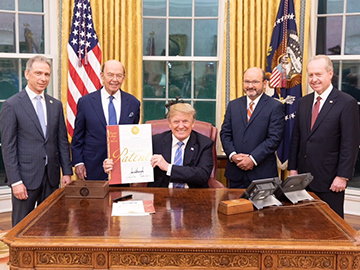
On 19 June, Joe Marron (second from right) visited the White House in Washington D.C. as U.S. President Donald J. Trump signed the 10 millionth U.S. patent. From left to right: Director of the U.S. Patent and Trademark Office Andrei Iancu, Secretary of Commerce Wilbur Ross, President Trump, Joe Marron and Raytheon CEO Thomas Kennedy. [Image: U.S. Patent & Trademark Office]
Joe Marron, OSA Fellow and optical engineer at Raytheon, was issued the 10 millionth U.S. patent on 19 June. He invented a laser radar data system, called "Coherent Ladar Using Intra-Pixel Quadrature Detection," that obtains real-time readings on speed and distance. This system could have many potential applications, including in autonomous vehicles. OPN caught up with Joe to discuss the career path that led him to such an impressive accomplishment:
Did you always know you wanted to be an inventor? Or is that something you discovered along the way?
Well, I knew I wanted to be a scientist. When I went to college my freshman year, I wanted to be a scientist so bad that I decided to be a physics major, electrical engineering major and a computer science major at the same time! They all didn’t work out. Instead I chose optics and pursued my education at the University of Rochester.
Can you tell me a bit about your new system and its applications?
To explain the technology, it’s a little like a digital camera. Except that each pixel, instead of detecting light intensity, is able to measure speed and distance. More specifically, in optics, we sometimes employ coherent detection systems that involve making measurements at very high speeds and at the pixel level. This invention allows recording information at the very high rates required to pull out the speed and distance information.
One of the applications we look at is autonomous vehicles or driverless cars. In that case, one needs a sensor that is able to look ahead and—again, similar to a digital camera—for each pixel determine distance and speed, so you can determine how far away objects are and how quickly you’re traveling toward them.
This system makes that process faster and more accurate.
This is not the first patent you’ve been issued. You’ve been raking in patents since 1991. Do you remember your first patent?
Yes, and it’s a funny coincidence because my first patent was just over the 5 millionth U.S. patent, and now this one is the 10 millionth. It was an improvement to bifocal lenses. I patented the use of birefringent lenses for bifocal systems.
A regular bifocal system involves having a line on your glasses. Now, we have progressive lenses, which have the optical power changing over the lens surface. With this patent, it imaged far things using one polarization and near things based on the other polarization of light. The two things occur simultaneously on the retina, and the brain is able to filter out the near or far image, whichever is in focus.
What advice do you have for young inventors who are about to embark on the journey of developing an idea and getting it patented?
I have two elements of advice: One is to fulfill your curiosity. If you think there’s a better way to do something, then commit time and energy to thinking about that and then tinker with it. The other piece of advice is: don’t give up. Keep thinking of new ways to solve the problem.

